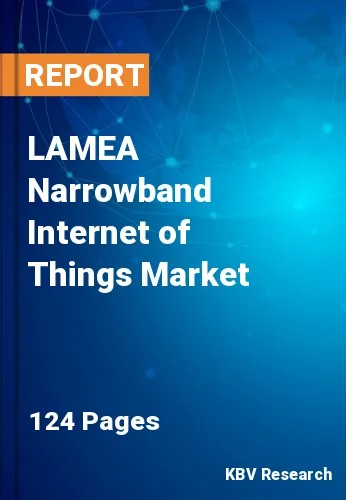The Latin America, Middle East and Africa Narrowband Internet of Things Market would witness market growth of 58.6% CAGR during the forecast period (2022-2028).
The growth of IoT devices in commercial applications is anticipated to enable the market to obtain an immense boost in the upcoming years. Furthermore, the developing NB-IoT ecosystem allows energy, utilities, and crucial infrastructure businesses to utilize vast IoT solutions to assist local communities and internal operations. Apart from this, the massive utilization of NB-IoT devices in several institutions across enterprises to enhance communication networks and operations substantiates market revenue. The rising embracement of IoT systems in several company systems and the developing digitization stimulates the market range.
The NB-IoT market is growing owing to the quick advancement and innovation in telecommunications technologies. The more modern and quick LTE technology is replacing the older, slower mobile communication networks because it can deliver high data speeds. As a result, there is now greater demand for faster speeds and better data throughputs. It is also projected that the advancement of 5G technology would surge the usage of NB-IoT.
Curitiba is considered as Brazil's most connected and smart city. In addition, Curitiba was a leader in developing the first Bus Rapid Transit (BRT) system, a network of bus lines that revolutionised how city residents get around. Additionally, the city offers its residents free internet access in public spaces. Projects including Fab Labs, urban farms, city navigation apps, and innovation clusters are being worked on in Curitiba.
In order to foster a creative atmosphere that will stimulate smart solutions in line with the fulfilment of the SDGs, Curitiba is promoting a smart city movement. Considering all this, it is projected that during the projection period, these variables will hasten the growth of the application of IoT in the smart cities. This would lead to regional market growth during the projection period.
The Brazil market dominated the LAMEA Narrowband Internet of Things Market by Country in 2021, and would continue to be a dominant market till 2028; thereby, achieving a market value of $171.5 million by 2028. The Argentina market would register a CAGR of 59.4% during (2022 - 2028). Additionally, The UAE market is poised to grow at a CAGR of 58.2% during (2022 - 2028).
Based on Component, the market is segmented into Solution and Services. Based on Application, the market is segmented into Alarms & Detectors, Smart Meters, Trackers, Wearable Devices, Smart Parking, Smart Lighting, and Others. Based on Deployment Mode, the market is segmented into Guard, Stand-alone, and In-band. Based on Vertical, the market is segmented into Infrastructure, Energy & Utilities, Automotive & Transportation, Agriculture, Healthcare, Consumer Electronics, Manufacturing, and Others. Based on countries, the market is segmented into Brazil, Argentina, UAE, Saudi Arabia, South Africa, Nigeria, and Rest of LAMEA.
Free Valuable Insights: The Global Narrowband Internet of Things Market is Predict to reach $9.6 Billion by 2028, at a CAGR of 51.5%
The market research report covers the analysis of key stake holders of the market. Key companies profiled in the report include Intel Corporation, Qualcomm, Inc., Huawei Technologies Co., Ltd. MediaTek, Inc., Nokia Corporation, Verizon Communications, Inc., AT&T, Inc., Vodafone Group Plc, Orange S.A., and Ericsson AB.
By Component
By Application
By Deployment Mode
By Vertical
By Country
Our team of dedicated experts can provide you with attractive expansion opportunities for your business.

